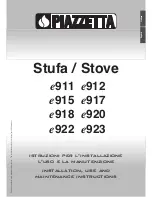
Installation and Instructions
10
Step 4: Secure the Firebox
Four (4) nailing flanges are supplied with the
fireplace to level the box and secure firmly in
place; Bend the nailing flanges from the sides of
the fireplace as shown in Figure 7.
Note: The nailing flanges have two (2) sets of
holes to allow for adjustment for
1
⁄
2
" or 1" offset of
the face of the unit. When installing the nailing
flanges, choose the set of holes on the nailing
flange that fit with your application.
Note: This firebox employs spacers, stand offs and
nailing flanges to inhibit contact of parts of the fire-
box with combustible construction .
do not alter the spacers or divert
from their intended use or notch the framing in
any manner.
Step 5: Gas Piping and Connection
The gas piping must be installed in accordance
with local codes or, in the absence of local codes,
in accordance with the National Fuel Gas Code,
ANSI Z223.1/NFPA 54, latest edition.
Piping should be tested for leaks prior to final wall
installation. Test for leaks, using a soap and water
solution or any acceptable solution or mechanical
gas leak detector, after completing the connection.
DO NOT USE OPEN FLAME.
Step 6: Optional Procedure for
Cold Climate Installations
The insulation and sealing of the enclosure around
the fireplace is very important in cold climates. If
the enclosure is insulated and sealed properly, you
can avoid future cold air problems. The time taken
to install the firebox correctly is well worthwhile.
The following steps are to stop potential cold air
problems. (Do not use Kraft Faced insulation -
paper faced)
Insulation of the Fireplace Enclosure
When in a chase or an outside wall, the fireplace
enclosure should be insulated like any other wall of
your home. Insulation should be installed on the
outside wall(s) and the wall about the fireplace.
(Do not use Kraft Faced insulation - paper faced.)
Insulate to Seal Under the Fireplace
Insulating under the fireplace is beneficial for
installations on a concrete slab in cold weather
climates. The fireplace should be placed on insulating
board. It is important that a hard, rigid surface be
maintained, so do not use fiberglass insulation for
this purpose.
WHEN INSTALLING A FIREPLACE
IN AN INSULATED ENCLOSURE, BE SURE TO
MAINTAIN ALL MARKED AIR SPACES. DO NOT
USE KRAFT (PAPER FACED) INSULATION .
Seal Seams
Sealing the seams of the fireplace is beneficial for
installations in cold weather climates where the outer
wall meets the bottom pan and the front face. Also
seal between the fireplace and finishing materials.
Use
high temperature
caulk. Refer to Figure 8 for
details of sealing spaces between the fireplace and
finishing materials.
DETAIL C
C
Fig. 7
Stand
Off
Caulking or Sealant
Noncombustible
Insulation
Finishing Material
Top View
Side View
Caulking or Sealant
Noncombustible Material
Finishing Material
Insulation
Stud
Fig. 8

































